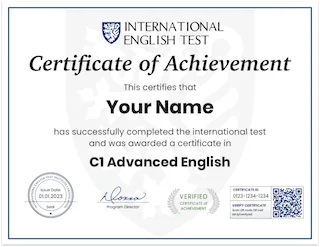In your first yoga class, you’ll come across terms like namaste and savasana. This list of common yoga terms will aid your practice.
Whether you’re joining classes in person or laying out your mat in front of your laptop to unwind after a busy day at the office, grasping yoga vocabulary is key to maximizing the benefits of your sessions.
This all-encompassing guide provides insights into common yoga terminology, aiding you in navigating this ancient practice. Explore essential terms along with examples of techniques and poses to ensure a seamless journey toward improved mental and physical well-being.
What is your English level?
Find out your A1 A2 B1 B2 C1 C2 level of English with our quick, free online test.
Common yoga terms
Our compilation of frequently used yoga terms is designed to enhance your comprehension of instructions in both in-person classes and online tutorials. By utilizing pronunciation guidance and offering examples for each technique and pose, we aim to ensure you stay on track (both literally and figuratively) in your yoga sessions, fostering a deeper connection to the practice.
Vinyasa (pronounced: vin-YAH-suh)
Vinyasa is a yoga style that integrates breath with movement. Participants in Vinyasa classes smoothly move through a series of asanas, coordinating each action with either an inhalation or exhalation. Additionally, the term Vinyasa encompasses the transitions between poses.
Namaste (pronounced: nah-MAH-stay)
Namaste is a courteous greeting used in both yoga classes and Hindu culture. It signifies “the divine in me bows to the divine in you” and is typically expressed at the commencement and conclusion of a yoga session, accompanied by the gesture of placing your hands in a prayer position at the center of your heart.
Asana (pronounced: AH-suh-nuh)
“Asana” translates to “posture” or “pose,” representing the physical positions engaged in during yoga.
It’s crucial to note the vast array of asanas, numbering in the hundreds, with varying levels of difficulty. However, fret not – your instructor is likely to offer different versions tailored for both beginners and advanced practitioners. They will also elucidate the distinctive advantages of each pose when introducing it to the class.
Pranayama (pronounced: prah-nah-YAH-mah)
Pranayama involves the discipline of breath control. In this context, “Prana” denotes life force or vital energy, and “ayama” signifies extension or control. The utilization of these breathing techniques can effectively reduce stress, promote mental calmness, improve concentration, and elevate energy levels.
Savasana (pronounced: shah-VAHS-uh-nuh)
Referred to as Corpse Pose, Savasana is a relaxation position commonly employed in the concluding phase of a yoga session. This pose enables the body to rest, facilitating the assimilation of the practice’s advantages, promoting relaxation, and alleviating stress.
Exploring Sanskrit in Yoga
This ancient language plays a crucial role in the yoga tradition. Many yoga terms and asana names have their roots in Sanskrit. Correct pronunciation and understanding enhance the flow of your sessions and are essential for delving into the spiritual aspects of the practice.
Explore our detailed pronunciation guide for key Sanskrit terms, along with examples of their usage in yoga sessions.
Tadasana (pronounced: tah-DAHS-uh-nuh)
Referred to as Mountain Pose, Tadasana is a fundamental standing position in yoga. Coming from the Sanskrit words “tada,” signifying mountain, and “asana,” meaning pose, it acts as the foundational stance for numerous standing sequences, contributing to enhanced posture and balance.
Ujjayi (pronounced: oo-JAH-yee)
Frequently known as the victorious breath or ocean breath, Ujjayi is a breathing method widely utilized in yoga. By gently narrowing the back of the throat during both inhalation and exhalation through the nose, practitioners can produce a calming sound reminiscent of ocean waves.
Chaturanga Dandasana (pronounced: chah-too-RAHN-guh dahn-DAHS-uh-nuh)
Chaturanga Dandasana, also known as Four-Limbed Staff Pose, is a demanding yoga position designed to enhance the strength of the arms, shoulders, and core. The name is derived from the combination of “chatur” (four), “anga” (limb), “danda” (staff), and “asana” (pose).
Surya Namaskar (pronounced: SOOR-yuh nah-MAHS-kahr)
Referred to as Sun Salutation, Surya Namaskar comprises a sequence of twelve interconnected poses, commonly used as a warm-up or basis for various yoga routines. The term combines “Surya” (sun) and “namaskar” (salutation). This series invigorates the body through muscle stretching and coordinated breathing.
Balasana (pronounced: bah-LAHS-uh-nuh)
You might be familiar with Balasana, commonly known as Child’s Pose. This mild, rejuvenating position can be integrated into sessions to promote relaxation and self-reflection. It aids in stretching the hips, thighs, and ankles, simultaneously alleviating stress and fatigue.
Virabhadrasana (pronounced: veer-uh-bhuh-DRAHS-uh-nuh)
Virabhadrasana, known as Warrior Pose, is a standing stance that enhances the strength of the legs, arms, and shoulders while refining balance and concentration. The pose has three variations: Warrior I, Warrior II, and Warrior III, each offering distinct alignments and advantages.
Trikonasana (pronounced: tree-koh-NAHS-uh-nuh)
Trikonasana, widely recognized as Triangle Pose, is a standing position designed to elongate the legs, hips, and spine, concurrently fortifying the lower body and core muscles. Additionally, it contributes to enhancing balance and concentration.
Bakasana (pronounced: bah-KAHS-uh-nuh)
Bakasana, also known as Crow Pose, is an arm-balancing position that tests strength, balance, and concentration. This advanced holistic pose is particularly effective for developing muscle strength in the arms, wrists, and core.
Ananda Balasana (pronounced: ah-NAHN-duh bah-LAHS-uh-nuh)
Ananda Balasana, commonly referred to as Happy Baby pose, is a soothing and rejuvenating position that provides stretches to the hips, inner thighs, and lower back. It aids in releasing tension and fostering relaxation.
Are you C1 Advanced English?
Get your C1 Advanced English certificate now!
✓ Add your certificate to your resume
⭐ ⭐ ⭐ ⭐ ⭐
Become a master of yoga terms
Gaining proficiency in yoga terminology is crucial for elevating your practice and strengthening your bond with this age-old discipline. In this all-encompassing guide to yoga vocabulary, we’ve delved into the importance of diverse techniques, explored Sanskrit terms, and examined various asanas and mindfulness practices.
Recognizing the connection between yoga vocabulary and mindfulness can assist in stress reduction, providing a means to unwind from work and fostering overall well-being.
What is your English level?
Find out your A1 A2 B1 B2 C1 C2 level of English with our quick, free online test.





